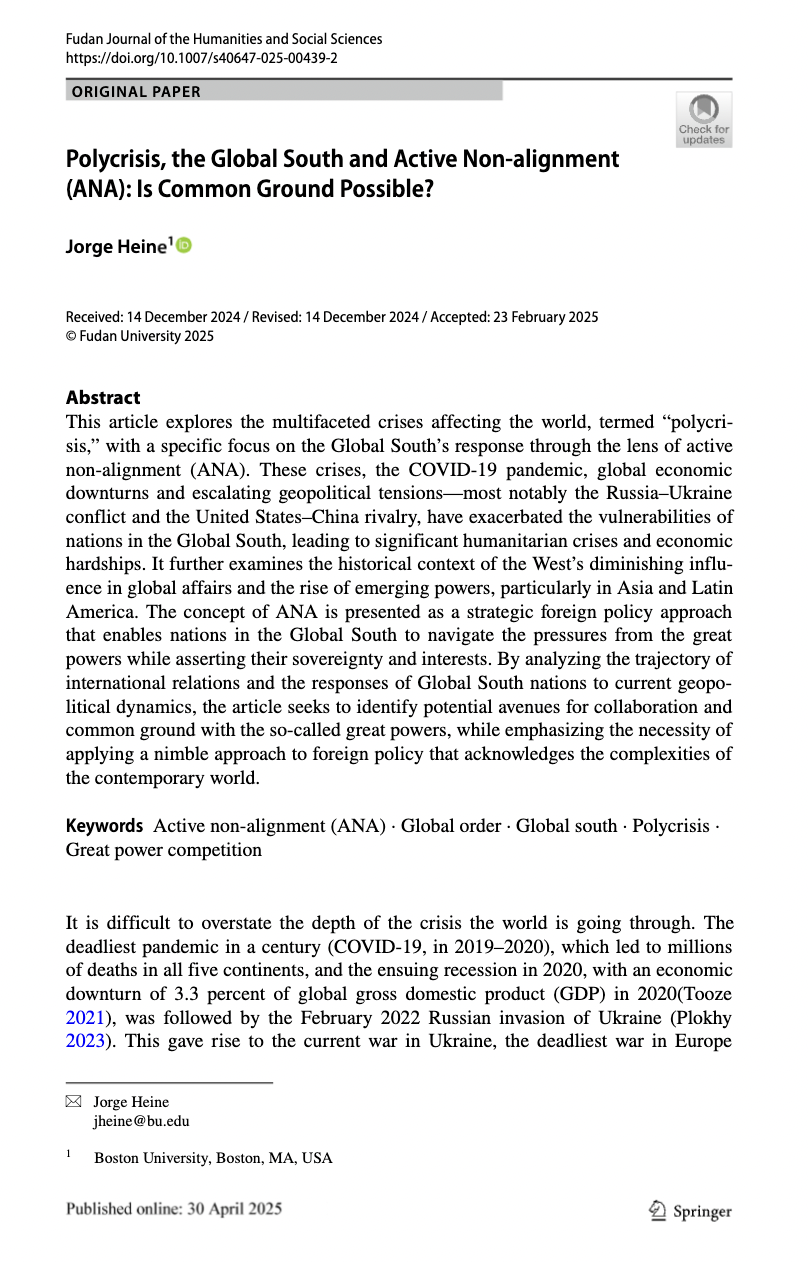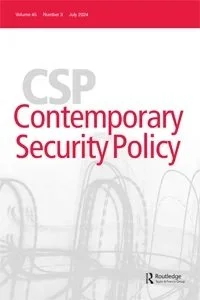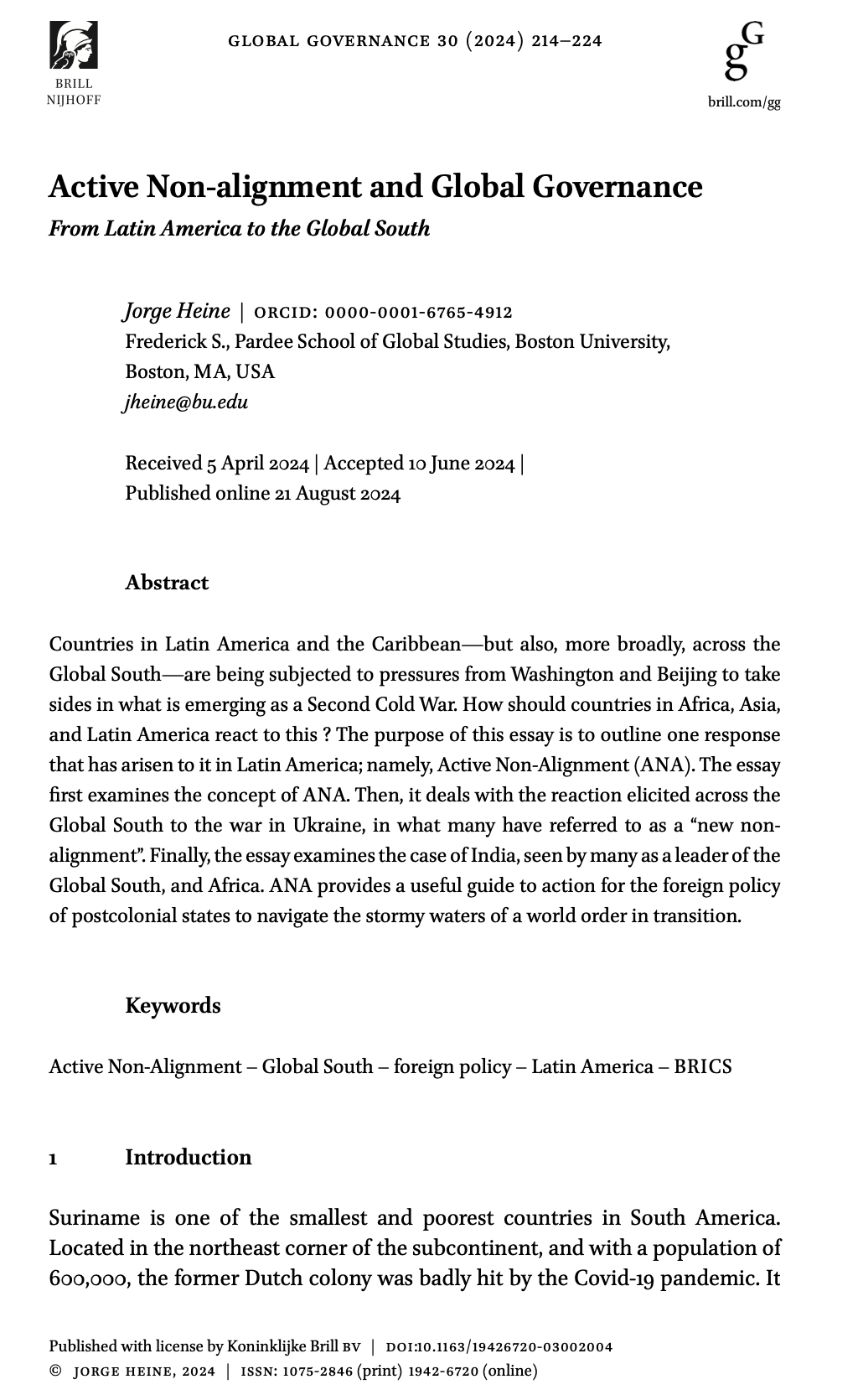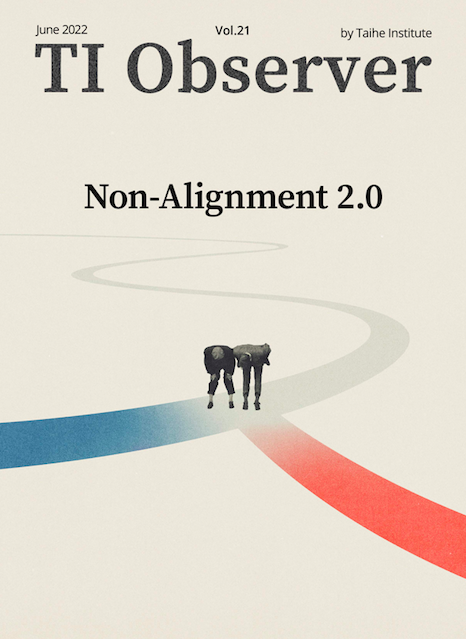América Latina, el No Alineamiento Activo y la disputa entre Estados Unidos y China
“América Latina, el No Alineamiento Activo y la disputa entre Estados Unidos y China”, Conexión América Latina, 4(2), 2025.
Polycrisis, the Global South and Active Non-alignment (ANA): Is Common Ground Possible?
Heine, Jorge. (2025) “Polycrisis, the Global South and Active Non-alignment (ANA): Is Common Ground Possible?”. Fudan J. Hum. Soc. Sci. https://doi.org/10.1007/s40647-025-00439-2
Abstract:
Abstract This article explores the multifaceted crises affecting the world, termed “polycrisis,” with a specific focus on the Global South’s response through the lens of active non-alignment (ANA). These crises, the COVID-19 pandemic, global economic downturns and escalating geopolitical tensions—most notably the Russia–Ukraine conflict and the United States–China rivalry, have exacerbated the vulnerabilities of nations in the Global South, leading to significant humanitarian crises and economic hardships. It further examines the historical context of the West’s diminishing influence in global affairs and the rise of emerging powers, particularly in Asia and Latin America. The concept of ANA is presented as a strategic foreign policy approach that enables nations in the Global South to navigate the pressures from the great powers while asserting their sovereignty and interests. By analyzing the trajectory of international relations and the responses of Global South nations to current geopolitical dynamics, the article seeks to identify potential avenues for collaboration and common ground with the so-called great powers, while emphasizing the necessity of applying a nimble approach to foreign policy that acknowledges the complexities of the contemporary world.
Trump 2.0 y el no alineamiento activo: Una respuesta a nuestros críticos
Fortin, Carlos; Heine, Jorge; Ominami, Carlos, (2025) “Trump 2.0 y el no alineamiento activo”, Foreign Affairs Latinoamérica, Vol. 25: Núm. 2, pp. 82-90. Disponible en: www.fal.itam.mx
Brazil, the BRICS and Active Non-Alignment
Heine, Jorge (2025), CEBRI-Journal, No. 13, January-March.
Not Picking Sides and the “New Neutrals”: Active Nonalignment, Great Power Competition, and the Global South
Heine, J. (2025). Not Picking Sides and the “New Neutrals”: Active Nonalignment, Great Power Competition, and the Global South. Journal of World Affairs, 0(0). https://doi.org/10.1177/29769442251324710
El No Alineamiento Activo y la competencia entre grandes poderes en nuestro tiempo
Asuntos Globales, Numéro 1, Diciembre 2024.
Active Non-Alignment and Great Power Competition in our Time
Global Affairs, Number 1, December 2024.
Active non-alignment, the sovereignty paradox and the Russia-Ukraine war
Heine, Jorge. 2024. “Active Non-Alignment, the Sovereignty Paradox and the Russia-Ukraine War.” Contemporary Security Policy, October, 1–10. doi:10.1080/13523260.2024.2413337.
ABSTRACT: The differing reactions between Western nations and the Global South to Russia’s invasion of Ukraine present a puzzle. Shouldn't post-colonial states be just as concerned about the principles of national sovereignty and non-intervention as Western countries? The idiosyncratic, ad hoc explanations on a country-by-country basis are insufficient to account for a much broader phenomenon. This article deconstructs the “sovereignty principle” as it is seen in the Global South and examines the standing of the so-called Rules-Based Order (RBO), allegedly under mortal threat by Russia’s action. It then argues that a far better explanation for the Global South’s reaction is the rise of Active Non-Alignment (ANA). The foreign policy doctrine of ANA arose in Latin America in 2019–2020 in response to US–China tensions, It then spread to the rest of the Global South in 2022–2024 because of the war in Ukraine, BRICS expansion, and the war in Gaza.
Active Non-alignment and Global Governance: From Latin America to the Global South
Abstract:
Countries in Latin America and the Caribbean—but also, more broadly, across the Global South—are being subjected to pressures from Washington and Beijing to take sides in what is emerging as a Second Cold War. How should countries in Africa, Asia, and Latin America react to this? The purpose of this essay is to outline one response that has arisen to it in Latin America; namely, Active Non-Alignment (ANA). The essay first examines the concept of ANA. Then, it deals with the reaction elicited across the Global South to the war in Ukraine, in what many have referred to as a “new non-alignment”. Finally, the essay examines the case of India, seen by many as a leader of the Global South, and Africa. ANA provides a useful guide to action for the foreign policy of postcolonial states to navigate the stormy waters of a world order in transition.
Heine, J. (2024). Active Non-alignment and Global Governance: From Latin America to the Global South. Global Governance: A Review of Multilateralism and International Organizations 30, 2, 214-224, Available From: Brill https://doi.org/10.1163/19426720-03002004
El No Alineamiento Activo y el Sur Global en la actual coyuntura internacional
"El No Alineamiento Activo y el Sur Global en la actual coyuntura internacional", Revista de Investigación en Política Exterior Argentina. 4(7) Enero 2024- Agosto 2024, pp. 14-26.
Pandémie et guerre en Ukraine : de la pertinence du concept de non-alignement actif pour l’Amérique latine
Carlos Fortin, Jorge Heine, Carlos Ominami, Revue internationale et stratégique 2023/2 (N° 130), pages 47 à 56.
European War and Global Pandemic: The Renewed Validity of Active Non-Alignment
with Carlos Fortin and Carlos Ominami, Global Policy, January 2023.
La renovada vigencia del No Alineamiento Activo
Con Carlos Fortin y Carlos Ominami, POLITICA EXTERIOR No 210 ( noviembre-diciembre de 2022).
China y Rusia: ¿nuevo eje autoritario o antigua entente cordial?
with Andrés Serbin, Foreign Affairs Latinoamérica, 2022, 22(3) julio-septiembre, pp. 2-10.
The Ukraine War and the Active Non-Alignment Option
in Taihe Institute Observer (TIO), Vol. 21, June 2022, pp. 1-5.
Entre el Asia y el Indo-Pacífico: sobre mapas, imaginarios y vocaciones de política exterior
Pensamiento Propio (julio-diciembre 2021), pp. 214-229.



















